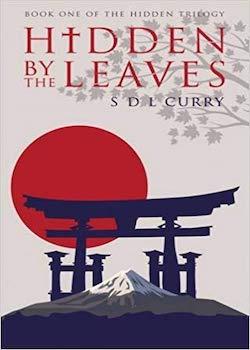Hidden by the Leaves

By S.D.L. Curry
Book Guild Publishing Ltd, 2016
Review by Harry Martin
Japan in the early 17th century can be seen on a par with modern day North Korea in terms of its self-imposed isolation, trade restrictions and political paranoia. The shogun of the time, Tokugawa Iemitsu, had revoked previous policies on international trade and movement of foreign nationals, enforcing in place strict commercial regulations and outright banishment of foreigners outside the specified trading ports in Southern Japan.
This period of national isolation, or sakoku in Japanese, coincided with the ongoing expansion of Christian missions within Japan’s borders, a movement which was aggressively and brutally suppressed at the time, resulting in mass persecution and the creation of a clandestine religious community. It is in this dramatic historical theatre that S.D.L. Curry’s Hidden by the Leaves is set.
Book one of the author’s new ‘Hidden Trilogy’, the story pursues Catholic Father Joaquim Martinez and his two junior clergy who have defied the shogun’s banishment laws and remained in Japan at great risk to help their oppressed Christian converts and the community to which they belong. What ensues is a remarkable yet brutal story of good vs evil, tracing the persecution of Catholic communities from the provincial towns of Kyushu to the trading ports of Osaka and Nagasaki and finally the Imperial majesty of Edo at the peak of Tokugawa rule.
The prose is vivid and illustrative in its depth of description, creating a pictorial sense of medieval Japan in both its beauty and its unbelievable brutality. This is clearly the work of a passionate and exceptionally well-informed historian who can at times draw the reader so far into the descriptions of torture and mutilation that the pages become uncomfortable to read. S.D.L. Curry’s writing imparts the sense of desperation and fear that the characters, and their historical counterparts, must have felt during this tumultuous time.
However, despite the factual historical context, this is very much a work of fiction with the writer’s empathy felt throughout. The theme of good vs evil is, at times, almost comically strong, with the ever-virtuous Catholic Father and his flock fighting against the injustice of the nefarious shogun and his villainous regime. For me, this provoked the desire to consider the other point of view – that of an island nation fiercely protecting its borders from foreign invasion and fighting for the preservation of its own endemic culture. This might also be an interesting alternative perspective to explore.
All in all this is an exciting, if bloodthirsty, work of fiction which explores a less romantic and gentle period of Japanese history. The universal theme of good vs evil brings warmly to light the resilience and bravery that can be found in times of desperation, and the historical context might inspire some readers to delve further into the background of Japan’s relations with the wider world.

